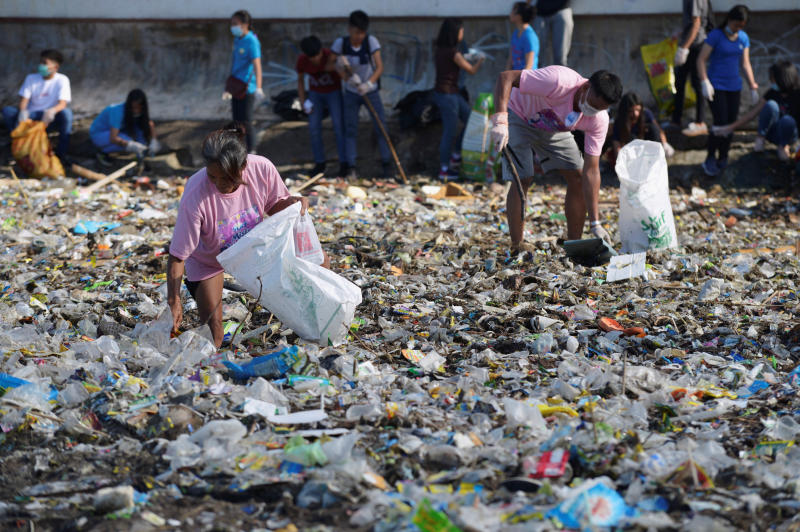After Boracay, Philippines targets Manila Bay's 'magnified cesspool' for next cleanup
Sign up now: Get ST's newsletters delivered to your inbox

Volunteers pick up trash along Manila Bay for World Coastal Clean Up Day in Manila on Sept 22, 2018.
PHOTO: REUTERS
Follow topic:
MANILA - After cleaning up the resort island of Boracay, environment officials here are now turning their attention to what may be the dirtiest body of water in the Philippines: Manila Bay.
"The next war we are going to wage is against #ManilaBay," Environment Secretary Roy Cimatu said in a tweet this week.
He announced that the government, using the same methods it used to rehabilitate Boracay, will set about next month making Manila Bay safe to swim in again.
He described Manila Bay, which at 1,900 sq km is nearly three times as large as Singapore, as a "magnified cesspool".
The bay is known for the bright, stunning colours of its sunsets.
Yet, it is also reviled for its malodorous, garbage-strewn, murky waters.
It has three times as many disease-causing coliform bacteria than a normal body of water.
Dr Janette Garin, a former health secretary, said swimming in Manila Bay is akin to "drinking others' urine", and worse. "That's how dirty it is," she said.
She said swimmers there risk diarrhoea, cholera, typhoid fever, hepatitis B and skin allergies.
Mr Cimatu said the focus, for now, is on metropolitan Manila. Manila Bay's long coastline that also encompasses the provinces of Bulacan and Bataan, north of Manila, and Cavite in the south.
He said a government task force will begin the operation by shutting down factories, oil depots and other establishments dumping untreated wastewater and toxic chemicals into Manila Bay.
Informal settlers living along the shoreline will also have to be relocated.
He said the environment department and 15 other government agencies are already putting the final touches on a "master plan" to coordinate all efforts to rehabilitate Manila Bay.
Mr Cimatu said the government "will show the same level of political will" as it did when it embarked on a massive cleanup of Boracay earlier this year.
The government shut down Boracay, famed for its powdery white beaches and shallow azure water, in April to fix sewage and environment-related problems that led to what President Rodrigo Duterte described as the island's degradation into a "cesspool".
"You go into the water, it's smelly. Smells of what? Shit," Mr Duterte had remarked.
Over six months, the government undertook a massive cleanup of Boracay.
Illegal pipes that dumped untreated sewage straight into the sea were removed. More sewage plants were built and others refurbished.
Buildings were bulldozed, and businesses pushed back to create a 30m buffer zone from the waterline. The island was reopened in October.
Critics, however, say Manila Bay presents an altogether different challenge, in terms of scale and complexity.
Boracay, for one, has a land area of just 10 sq km. Yet Manila Bay "is a giant waste dump" for roughly 13 million people living in the capital, according to advocacy group Greenpeace, which also called it a "hideous cocktail" of sewage, toxic industrial wastes, oil spills, leachate from garbage dumps, and run-offs from farm chemicals.
Greenpeace estimates that the degradation of the bay itself and surrounding coastal areas lead to at least 4 billion pesos (S$100 million) in damages each year, including costs arising from waterborne diseases.
"While we welcome the pronouncement to clean up Manila Bay, we have yet to see a clear plan on how (the government) will do it in a more holistic manner. The degradation and pollution of Manila Bay is a systemic problem, and change has to be addressed at source," said Ms Abigail Aguilar, a campaigner from Greenpeace South-east Asia (Philippines).
She said corporations would have to be held responsible for producing excessive amounts of single-use plastics.
Greenpeace this year set off on a campaign to "shame" consumer giants to force them to find environment-friendly alternatives to cheap, disposable plastic products.
A week-long cleanup of a small marine sanctuary along Manila Bay in September yielded more than 54,200 pieces, or about 1,040 kg, of plastic waste. There were also a good amount of nappies, sanitary napkins and glass.
A "brand audit" showed Nestle, Unilever, and Procter & Gamble were among the worst offenders.
The government could also have to strictly implement the law on ecological solid waste management, and compel companies to disclose their use and discharge of chemicals and other wastes.
"It is a step in the right direction, albeit delayed, and must be done with full participation of impacted communities who get their living from Manila Bay. A more comprehensive road map must be in place involving all stakeholders," said Ms Aguilar.

